GIS-Based Model for Constructing Ecological Efficiency Maps of Urban Green Areas: The Case Study of Western Naples, Italy
Abstract
:1. Introduction
- -
- Implementation of a light hierarchical GIS model that can evaluate the ecological efficiency of urban green spaces. Based on their dimensional and vegetal characteristics, the model provides a map of the ecological potential of existing urban greenspaces.
- -
- Support urban green infrastructures design strategies by prioritizing the existing green areas that deliver evo-transpiring services. The GIS-based model aims to increase specific knowledge to recognize the ecological efficiency of urban green areas.
2. Definitions and Assumptions
2.1. Adopted Definition of Green Infrastructure
- -
- Core areas, with reference to the most robust and resilient areas of the system, whose efficiency supports the production of ES.
- -
- Intermediate zones, referring to small and medium-sized areas that represent important elements for improving connectivity in the network due to their strategic location and/or their ecological efficiency.
- -
- Hubs, consisting of small to very small zones acting as a point connection to support the production of ES locally in the network.
2.2. Adopted Definition of Ecological Efficiency
3. Material and Methods
3.1. The Proposed Model
- Design of a GIS-based model in a hierarchical structure (Figure 1). To evaluate the ecological efficiency of urban green areas we have constructed a hierarchical model of indicators, following the approach presented in [48]. The final indicator, called ecological efficiency, is calculated in relation to two intermediate indicators, called dimension efficiency and vegetation efficiency. These latter give the contribute of the dimension and the shape of the green areas, and the contribute of the type and the diversity of the vegetation in the green areas.
- Identification of major indicators. For each intermediate indicator in the hierarchical model the urban green areas characteristics have been detected (Figure 2). The dimensional efficiency indicator is assessed by the size and compactness of the green area. The size indicator is assessed through the green area calculation, while compactness is estimated by comparing the shape of the green surface to a perfectly circular surface, according to the perimeter/area ratio [31]. The vegetation efficiency indicator is evaluated based on the Vegetative Structure and the Vegetative Diversity. The Vegetative Structure is measured through the values of the Normalized Difference Vegetation Index (NDVI). This is an index measuring the greening of the green surface biomes. The Vegetative Diversity indicator was measured by five diversity classes referred to the General Land Use (GLU). These indicators comply with the literature [21,31,33,39].
- Develop criteria for standardization and measurement of the above-mentioned indicators. Each indicator is represented by a specific set of equivalence classes in which the green spaces are divided according to their characteristics. For each class the rule has been determined to assign a green space to this class.
- Model implementation. The hierarchical model was implemented in a tool GIS platform. For each indicator, a thematic map was produced using geographic processing operators and spatial analysis features. We have implemented these features in the GIS ESRI ArcGIS 10.xtool. To implement the hierarchical model, we built a spatial database containing all the matrix and vector spatial entities needed to calculate the indicators. The output of this phase is the ecological efficiency map on the study area.
- Patches identification. The ecologically efficient green areas (patches) are detected in the existing urban green areas as those consistent with the full set of indicators proposed by the model and partitioned by typology. Patches are classified according to their dimensional characteristics; add-on patches belonging to the same class are aggregated to form potential components of urban green infrastructure. Finally, a map of the patches potentially included in a green urban infrastructure is developed.
3.2. The Study Area: The Western Part of the Municipality of Naples (Italy)
4. Experimental Results
5. Discussion of the Results
6. Conclusions
Author Contributions
Funding
Institutional Review Board Statement
Informed Consent Statement
Data Availability Statement
Acknowledgments
Conflicts of Interest
References
- Ahern, J. Urban landscape sustainability and resilience: The promise and challenges of integrating ecology with urban planning and design. Landsc. Ecol. 2013, 28, 1203–1212. [Google Scholar] [CrossRef]
- Kershaw, T. Climate Change Resilience in Urban Environments; IOP Publishing: Bristol, UK, 2017. [Google Scholar] [CrossRef]
- Millennium Ecosystem Assessment (MEA). Ecosystems and Human Well-Being: Synthesis; Island Press: Washington, DC, USA, 2005; ISBN 1-59726-040-1. [Google Scholar]
- Herberg, A.; Kube, A. Klimawandel und Städte: Naturschutz und Lebensqualität. In Biodiversität und Klimawandel; Essl, F., Rabitsch, W., Eds.; Springer Spektrum: Berlin/Heidelberg, Germany, 2013; pp. 254–263. ISBN 13:9783642296925. [Google Scholar]
- Demuzere, M.; Orru, K.; Heidrich, O.; Olazabal, E.; Geneletti, D.; Orru, H.; Bhave, A.G.; Mittal, N.; Feliú, E.; Faehnle, M. Mitigating and adapting to climate change: Multi-functional and multi-scale assessment of green urban infrastructure. J. Environ. Manag. 2014, 146, 107–115. [Google Scholar] [CrossRef] [PubMed]
- Tzoulas, K.; Korpela, K.; Venn, S.; Yli-Pelkonen, V.; Ka´zmierczak, A.; Niemela, J.; James, P. Promoting ecosystem and human health in urban areas using green infrastructure: A literature review. Landsc. Urban Plan. 2007, 81, 167–178. [Google Scholar] [CrossRef] [Green Version]
- Valente, R. Multi-scale Environmental design experiences. In Adapting to the Changing Climate. Knowledge Innovation for Environmental Design; Losasso, M., Lucarelli, M.T., Rigillo, M., Valente, R., Eds.; Maggioli: Rimini, Italia, 2020. [Google Scholar]
- Ajuntamiento de Barcelona. Barcelona Green Infrastructure and Biodiversity Plan. 2013. Available online: https://ajuntament.barcelona.cat/ecologiaurbana/sites/ (accessed on 1 January 2013).
- NYC Department of Environmental Protection (DEP). NYC Green Infrastructure Plan: A Sustainable Strategy for Clean Waterways, New York City. 2012. Available online: https://www1.nyc.gov/assets/dep/downloads/pdf/water/stormwater/green-infrastructure/nyc-green-infrastructure-plan-2010.pdf (accessed on 1 January 2012).
- European Environmental Agency, Green Infrastructure and Territorial Cohesion. The Concept of Green Infrastructure and Its Integration into Policies Using Monitoring Systems; Technical Report No 18/2011; Publications Office of the European Union: Luxembourg, 2011; ISBN 978-92-9213-242-2. [Google Scholar]
- Science for Environment Policy. The Multifunctionality of Green Infrastructure; In-Depth Reports; Directorate-General for the Environment, Science for Environment Policy, European Commission: Brussels, Belgium, 2012. [Google Scholar]
- European Commission Communication from the Commission to the European Parliament, the Council, the European Economic and Social Committee and the Committee of the Regions. Green Infrastructure (GI)—Enhancing Europe’s Natural Capital; COM/2013/0249 Final. Available online: http://eur-lex.europa.eu/legal-content/EN/TXT/?uri=CELEX:52013DC0249 (accessed on 6 May 2013).
- European Commission, Report from the Commission to the European Parliament, the Council, the European Economic and Social Committee and the Committee of the Regions, Review of progress on implementation of the EU green infrastructure strategy, COM (2019) 236 Final. Available online: https://eur-lex.europa.eu/legal-content/EN/TXT/PDF/?uri=CELEX:52019DC0236&qid=1562053537296 (accessed on 24 May 2019).
- European Commission, Commission Staff Working Document Additional Information on the Review of Implementation of the Green Infrastructure Strategy, SWD (2019) 184 Final. Available online: https://eur-lex.europa.eu/legal-content/EN/TXT/PDF/?uri=CELEX:52019DC0236&qid=1562053537296 (accessed on 24 May 2019).
- European Commission, Commission Staff Working Document, Technical Information on Green Infrastructure (GI), COM/2013/0249 Final. Available online: https://ec.europa.eu/environment/nature/ecosystems/docs/green_infrastructures/1_EN_ACT_part1_v5.pdf (accessed on 6 May 2013).
- Costanza, R.; d’Arge, R.; de Groot, R.; Farber, S.; Grasso, M.; Hannon, B.; Limburg, K.; Naeem, S.; O’Neill, R.V.; Paruelo, J.; et al. The Value of the World’s Ecosystem Services and Natural Capital. Nature 1997, 387, 253–260. [Google Scholar] [CrossRef]
- Potschin, M.; Haines-Young, R. Ecosystem services. Exploring a geographical perspective. Physical. Geogr. 2011, 35, 575–594. [Google Scholar] [CrossRef]
- Naumann, S.; McKenna, D.; Kaphengst, T.; Pieterse, M.; Rayment, M. Design, Implementation and Cost Elements of Green Infrastructure Projects; Final Report to the European Commission; Ecologic Institute and GHK Consulting: Overland Park, KS, USA, 2011; Available online: https://ec.europa.eu/environment/enveco/biodiversity/pdf/GI_DICE_FinalReport.pdf (accessed on 19 January 2019).
- Costanza, R.; de Groot, R.; Sutton, P.; van der Ploeg, S.; Anderson, S.J.; Kubiszewski, I.; Farber, S.; Turner, R.K. Changes in the global value of ecosystem services. Glob. Environ. Change 2014, 26, 152–158. [Google Scholar] [CrossRef]
- United Nations, System of Environmental-Economic Accounting—Ecosystem Accounting (SEEA EA). White Cover Publica-tion, Pre-Edited Text Subject to Official Editing. December 2021. Available online: https://seea.un.org/ecosystem-accounting (accessed on 1 January 2022).
- Sun, R.; Liu, S. Effects of green space dynamics on urban heat islands: Mitigation and diversification. Ecosyst. Serv. 2017, 23, 38–46. [Google Scholar] [CrossRef]
- Meerow, S.; Newell, J.P. Spatial planning for multifunctional green infrastructure: Growing resilience in Detroit. Landsc. Urban Plan. 2017, 159, 62–75. [Google Scholar] [CrossRef]
- Yu, Z.; Yang, G.; Zuo, S.; Jørgensen, G.; Koga, M.; Vejre, H. Critical review on the cooling effect of urban blue-green space: A threshold-size perspective. Urban For. Urban Green. 2020, 49, 126630. [Google Scholar] [CrossRef]
- Jaganmohan, M.; Knapp, S.; Buchmann, C.M.; Schwarz, N. The Bigger, the Better? The Influence of Urban Green Space Design on Cooling Effects for Residential Areas. J. Environ. Qual. 2016, 45, 134–145. [Google Scholar] [CrossRef]
- Monteiro, M.V.; Doick, K.J.; Handley, P.; Peace, A. The impact of greenspace size on the extent of local nocturnal air temperature cooling in London. Urban For. Urban Green. 2016, 16, 160–169. [Google Scholar] [CrossRef]
- Hathway, E.; Sharples, S. The interaction of rivers and urban form in mitigating the Urban Heat Island effect: A UK case study. Build. Environ. 2012, 58, 14–22. [Google Scholar] [CrossRef] [Green Version]
- Skelhorn, C.; Lindley, S.; Levermore, G. The impact of vegetation types on air and surface temperatures in a temperate city: A fine scale assessment in Manchester, UK. Landsc. Urban. Plan. 2014, 121, 129–140. [Google Scholar] [CrossRef]
- Jiang, Y.; Jiang, S.; Shi, T. Comparative Study on the Cooling Effects of Green Space Patterns in Waterfront Build-Up Blocks: An Experience from Shanghai. Int. J. Environ. Res. Public Health 2020, 17, 8684. [Google Scholar] [CrossRef] [PubMed]
- Liao, W.; Hong, T.; Heo, Y. The effect of spatial heterogeneity in urban morphology on surface urban heat islands. Energy and Buildings 2021, 244, 112027. [Google Scholar] [CrossRef]
- Tan, Z.; Lau, K.K.-L.; Ng, E. Urban tree design approaches for mitigating daytime urban heat island effects in a high-density urban environment. Energy Build. 2016, 114, 265–274. [Google Scholar] [CrossRef]
- Cook, E.A. Landscape structure indices for assessing urban ecological networks. Landsc. Urban Plan. 2002, 58, 269–280. [Google Scholar] [CrossRef]
- Benedict, M.A.; McMahon, E.T. Green Infrastructure: Linking Landscapes and Communities; Island Press: Washington, DC, USA, 2006; p. 299. ISBN 978-1559635585. [Google Scholar]
- Parker, J.; Zingoni de Baro, M.E. Green Infrastructure in the Urban Environment: A Systematic Quantitative Review. Sustainability 2019, 11, 3182. [Google Scholar] [CrossRef] [Green Version]
- Ying, J.; Zhang, X.; Zhang, Y.; Bilan, S. Green infrastructure: Systematic literature review. Econ. Res. Ekon. Istraživanja 2021, 23, 1–22. [Google Scholar] [CrossRef]
- Wang, J.; Banzhaf, E. Towards a better understanding of Green Infrastructure: A critical review. Ecol. Indic. 2018, 85, 758–772. [Google Scholar] [CrossRef]
- Mussinelli, E.; Tartaglia, A.; Bisogni, L.; Malcevschi, S. The role of Nature-Based Solutions in architectural and urban design. Techne J. Technol. Environ. 2019, 15, 116–123. [Google Scholar] [CrossRef]
- Staccione, A.; Candiago, S.; Mysiak, J. Mapping a Green Infrastructure Network: A framework for spatial connectivity applied in Northern Italy. Environ. Sci. Policy 2022, 131, 57–67. [Google Scholar] [CrossRef]
- Liquete, C.; Kleeshulte, S.; Dige, G.; Maes, J.; Grizzetti, B.; Olah, B.; Zulian, G. Mapping Green Infrastructure based on ecosystem services and ecological networks: A Pan-European Case Study. Environ. Sci. Policy 2015, 54, 268–280. [Google Scholar] [CrossRef]
- Forman, R.; Godron, M. Patches and structural components for a landscape ecology. BioScience 1981, 31, 733–740. [Google Scholar]
- European Commission. Building a Green Infrastructure for Europe; Publications Office of the EU: Luxembourg, 2013; Available online: https://op.europa.eu/en/publication-detail/-/publication/738d80bb-7d10-47bc-b131-ba8110e7c2d6 (accessed on 1 October 2021).
- Fenu, G.; Pau, P.L. Connectivity analysis of ecological landscape networks by cutnode ranking. Appl. Netw. Sci. 2018, 3, 1–15. [Google Scholar] [CrossRef] [Green Version]
- Lindeman, R.L. The trophic-dynamic aspect of ecology. Ecology 1942, 23, 399–418. [Google Scholar] [CrossRef]
- Ricklefs, R.E.; Miller, G.; Miller, G.L. Ecology; W H Freeman & Co.: New York, NY, USA, 2000; p. 822. ISBN 9780716728290. [Google Scholar]
- Jiadai, Y.; Pengpeng, X.; Zhijin, H. Impact of urbanization on ecological efficiency in China: An empirical analysis based on provincial panel data. Ecol. Indic. 2021, 129, 107827. [Google Scholar] [CrossRef]
- Yan, L.; Jinning, Z.; Xiaodong, Y.; Weilong, W.; Haitao, W.; Qiying, R.; Rundong, L. The impact of innovative city construction on ecological efficiency: A quasi-natural experiment from China. Sustain. Prod. Consum. 2021, 28, 1724–1735. [Google Scholar] [CrossRef]
- Haase, D.; Larondelle, N.; Andersson, E.; Artmann, M.; Borgström, S.; Breuste, J.; Gomez-Baggethun, E.; Gren, Å.; Hamstead, Z.; Hansen, R.; et al. A Quantitative Review of Urban Ecosystem Service Assessments: Concepts, Models, and Implementation. AMBIO 2014, 43, 413–433. [Google Scholar] [CrossRef] [Green Version]
- Estreguil, C.; Dige, G.; Kleeschulte, S.; Carrao, H.; Raynal, J.; Teller, A. Strategic Green Infrastructure and Ecosystem Restoration: Geospatial Methods, Data and Tools; EUR 29449 EN; Publications Office of the European Union: Luxembourg, 2019; ISBN 978-92-79-97294-2. JRC113815. [Google Scholar] [CrossRef]
- Di Martino, F.; Sessa, S. Methodology and hierarchical model for the assessment of the climatic vulnerability of the urban system. In Environmental Design for Climate Change adaptation. 2. Tools and Guidelines for Climate Risk Reduction; D’Ambrosio, V., Leone, M., Eds.; CLEAN: Napoli, Italy, 2019; pp. 46–57. ISBN 978-88-8497-731-1. [Google Scholar]
- Apreda, C.; D’Ambrosio, V.; Di Martino, F. A climate vulnerability and impact assessment model for complex urban systems. Environ. Sci. Policy 2019, 93, 11–26. [Google Scholar] [CrossRef]
- Russo, F.; Calderoni, G. The geomorphological evolution of the outskirts of Naples during the Holocene: A case study of the Bagnoli-Fuorigrotta depression. Holocene 1998, 8, 581–588. [Google Scholar] [CrossRef]

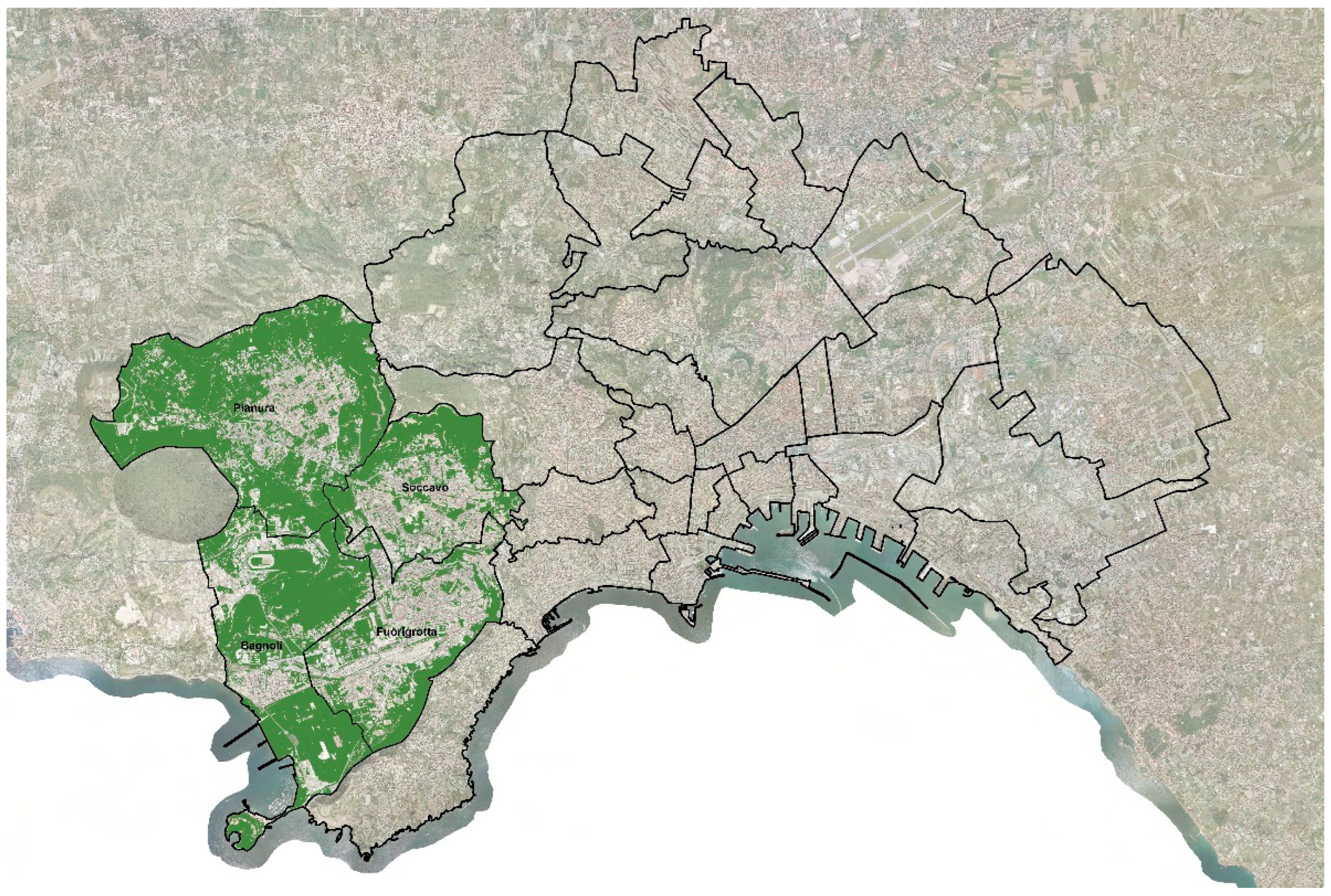

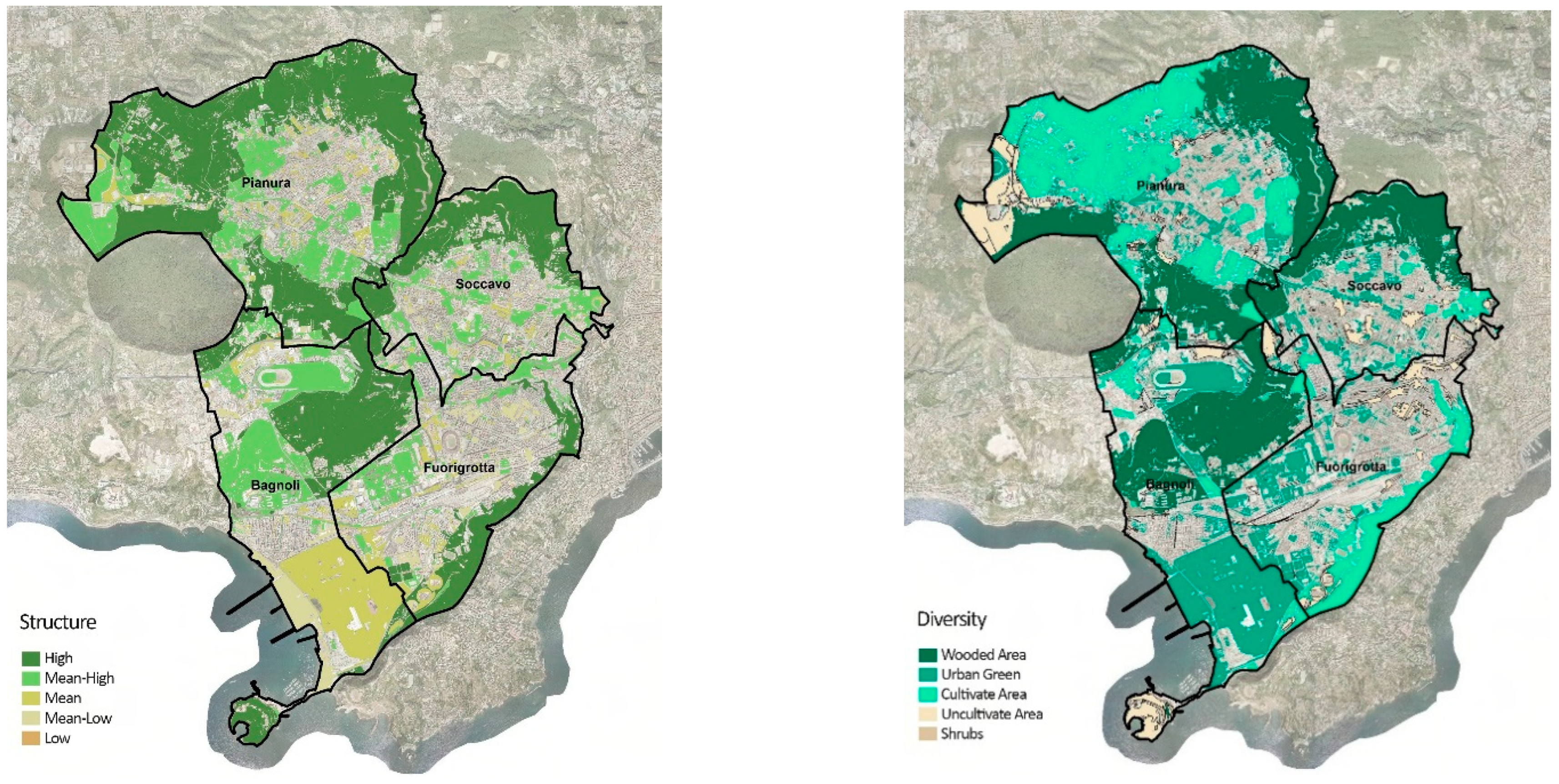
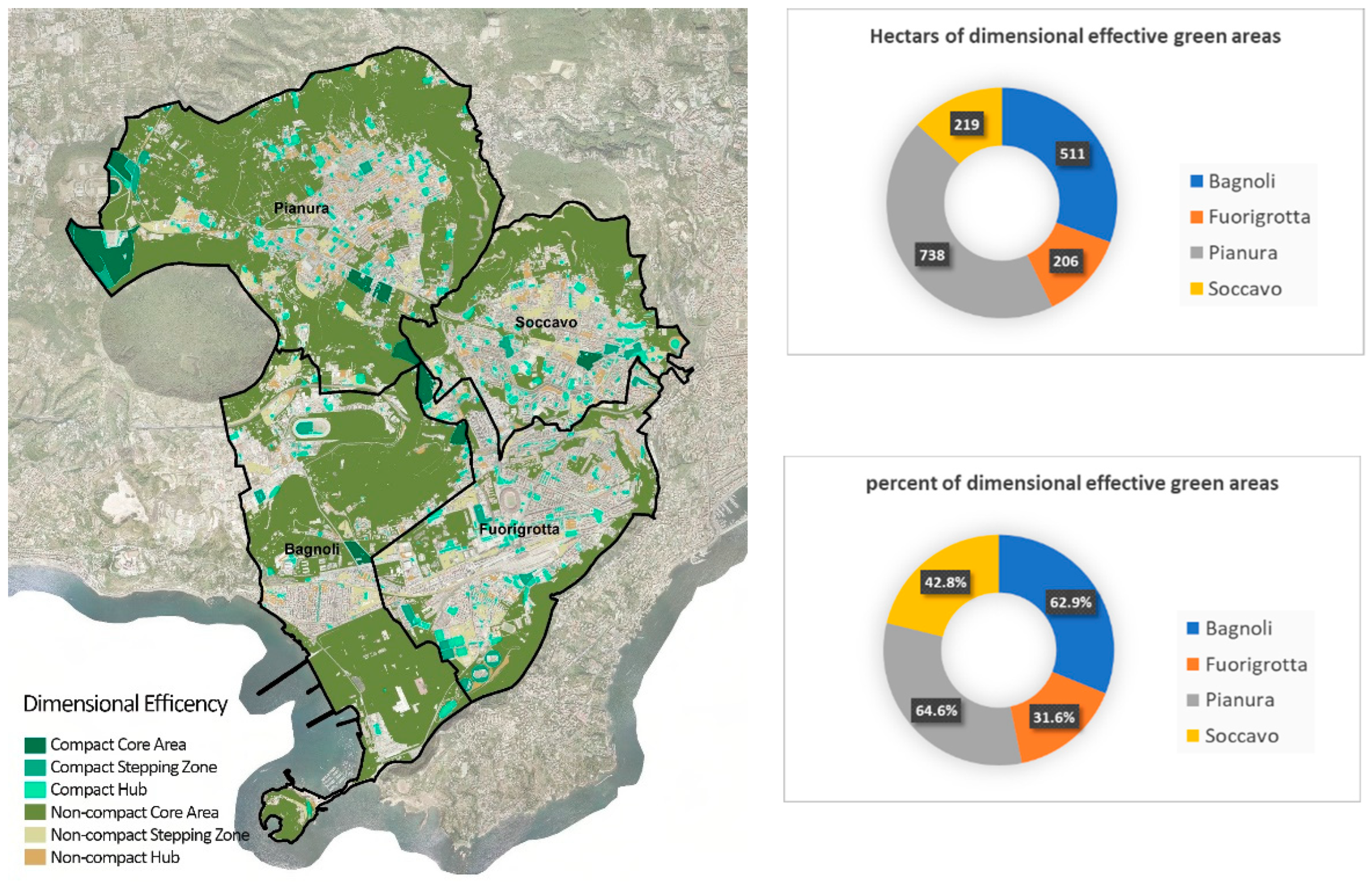
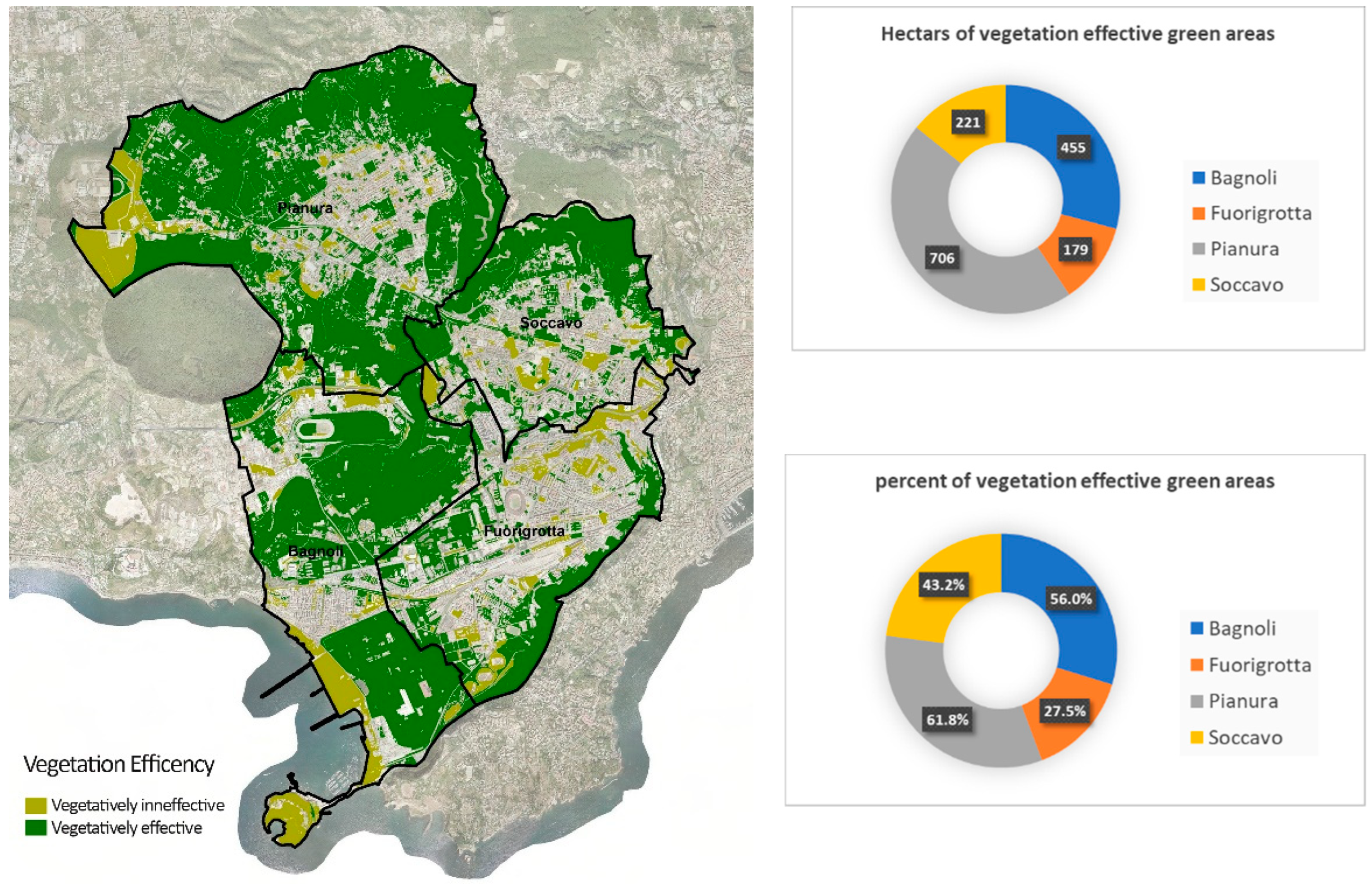
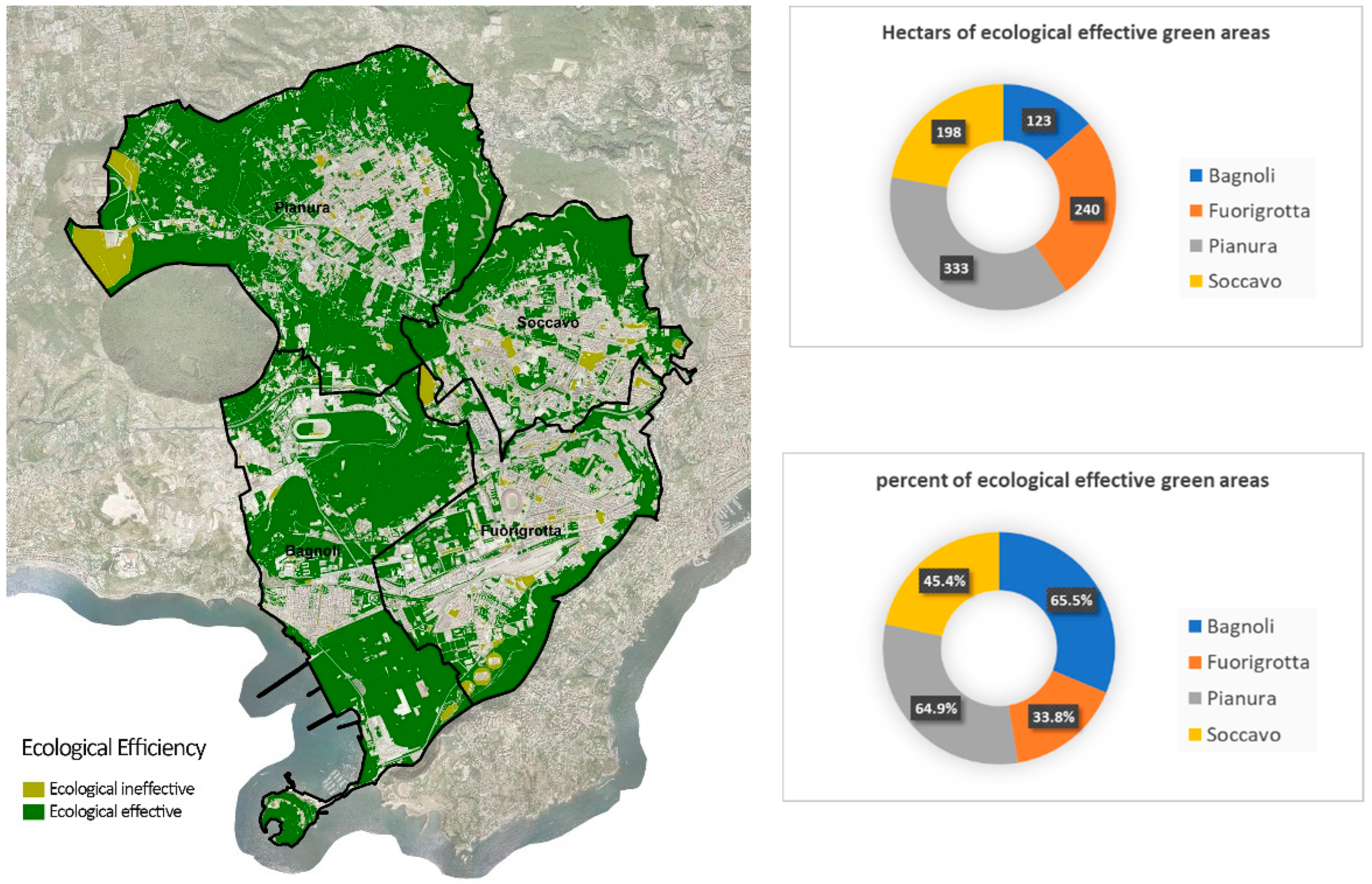

| Size Class | Rule |
|---|---|
| Very Wide | A > 3 Hectares |
| Sufficiently Wide | 1 Hectare < A ≤ 3 Hectares |
| Not Wide | A ≤ 1 Hectares |
| Compactness Class | Rule |
|---|---|
| Compact | CR < 0.60 |
| Non-compact | CR ≥ 0.60 |
| Dimensional Efficiency Class | Rule |
|---|---|
| Compact Core area | Size = Very wide, Compactness = Compact |
| Compact Stepping zone | Size = Sufficiently wide, Compactness = Compact |
| Compact Hub | Size = Not wide, Compactness = Compact |
| Non-compact Core area | Size = Very wide, Compactness = Non-compact |
| Non-compact Stepping zone | Size = Sufficiently wide, Compactness = Non-compact |
| Non-compact Hub | Size = Not wide, Compactness = Non-compact |
| Structure Class | Rule |
|---|---|
| Low | 0.00 ≤ NDVI < 0.10 |
| Mean-Low | 0.10 ≤ NDVI < 0.20 |
| Mean | 0.20 ≤ NDVI < 0.30 |
| Mean-High | 0.30 ≤ NDVI < 0.50 |
| High | 0.50 ≤ NDVI ≤ 1.00 |
| General Land Use (GLU) Class | Detailed Land Use (DLU) Class |
|---|---|
| Wooded area | Decayed deciduous forests Chestnut groves Degraded chestnut groves Holm oak woods Pine forests Robinia woods Robinia thickets Mixed arboretums of varying structural complexity and vineyards Specialized arborets Arboretums and tree gardens |
| Urban Green | Meadows and grassy slopes Bushes of the ruderal areas Herbaceous vegetation of the ruderal areas Urban green areas |
| Cultivate area | Arborate gardens with high structural complexity Horticultural crops on large ridged or sub-flat surfaces Horticultural, floricultural and arable crops Vegetable gardens and arable land of areas on hydromorphic soils |
| Uncultivated area | Former farm Former terraced farms Uncultivated areas |
| Shrubs | High stain Low stain Sparse bushes |
| Diversity Class | Rule |
|---|---|
| Wood | GLU = Wooded area |
| Urban Green | GLU = Urban Green |
| Cultivate area | GLU = Cultivate area |
| Uncultivated area | GLU = Uncultivated area 0.50 |
| Shrubs | GLU = Shrubs |
| Vegetation Efficiency Class | Rule |
|---|---|
| Vegetation effective | (Structure = Mean) OR (Structure = Mean-High) OR (Structure = High) |
| AND (Diversity = Wooded Area) OR (Diversity = Urban green) OR (Diversity = Cultivate Area) | |
| Vegetation ineffective | Otherwise |
| Ecological Efficiency Class | Rule |
|---|---|
| Ecologically effective | Dimensional efficiency = Compact or not compact Core area) OR (Dimensional efficiency = Compact Stepping zone) OR (Dimensional efficiency = Compact Hub) |
| AND (Vegetation efficiency = Vegetation effective) | |
| Ecologically ineffective | Otherwise |
| Patch Class | Rule |
|---|---|
| Core area | (Ecological efficiency = Ecologically effective) AND (Dimensional efficiency = Compact or not compact Core area) |
| Stepping zone | (Ecological efficiency = Ecologically effective) AND (Dimensional efficiency = Compact Stepping zone) |
| Hub | (Ecological efficiency = Ecologically effective) AND (Dimensional efficiency = Compact Hub) |
| Source | Source Dataset | Format |
|---|---|---|
| ISTAT | Partitioning of the municipality into census areas | Polygons census areas in scale 1:10,000 in ESRI shape format |
| ISTAT | Dataset of the population and building census aggregated by census zones | Census population and buildings data in csv format |
| Campania region | Last recent topographic database | Points, polylines and polygons of the topographic database in scale 1:5000 in ESRI shape format |
| Municipality of Naples | Partitioning of the municipal area in districts | Polygons districts in scale 1:5000 in ESRI shape format |
| Sentinel 2 satellite | NDVI Index evaluates the presence of photosynthetic activity | Raster of the NDVI index in Geo-Tiff format |
| Copernicus land use data | Land Use classification | Polygons Land Use in scale 1:10,000 in Esri shape format |
Publisher’s Note: MDPI stays neutral with regard to jurisdictional claims in published maps and institutional affiliations. |
© 2022 by the authors. Licensee MDPI, Basel, Switzerland. This article is an open access article distributed under the terms and conditions of the Creative Commons Attribution (CC BY) license (https://creativecommons.org/licenses/by/4.0/).
Share and Cite
D’Ambrosio, V.; Di Martino, F.; Rigillo, M. GIS-Based Model for Constructing Ecological Efficiency Maps of Urban Green Areas: The Case Study of Western Naples, Italy. Sustainability 2022, 14, 6830. https://doi.org/10.3390/su14116830
D’Ambrosio V, Di Martino F, Rigillo M. GIS-Based Model for Constructing Ecological Efficiency Maps of Urban Green Areas: The Case Study of Western Naples, Italy. Sustainability. 2022; 14(11):6830. https://doi.org/10.3390/su14116830
Chicago/Turabian StyleD’Ambrosio, Valeria, Ferdinando Di Martino, and Marina Rigillo. 2022. "GIS-Based Model for Constructing Ecological Efficiency Maps of Urban Green Areas: The Case Study of Western Naples, Italy" Sustainability 14, no. 11: 6830. https://doi.org/10.3390/su14116830
APA StyleD’Ambrosio, V., Di Martino, F., & Rigillo, M. (2022). GIS-Based Model for Constructing Ecological Efficiency Maps of Urban Green Areas: The Case Study of Western Naples, Italy. Sustainability, 14(11), 6830. https://doi.org/10.3390/su14116830







